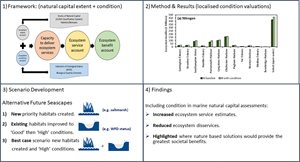Story
Ecosystem ‘health’ considerations help deliver a more precise approach for active marine habitat management and restoration
03 August 2022
A new study has been published to help improve understanding of the link between marine habitat “health’ and ecosystem service provision, by using comparable habitat condition indicators in order to make more informed conservation and restoration management decisions.

The study, undertaken by partners at the University of Portsmouth and Plymouth Marine Laboratory, showed that by including condition data in Natural Capital and Nature-based Solutions assessments in a specific case study area, the forecasted benefit of ecosystems service, such as nutrients and carbon burial in sediments, could be increased by as much as 67%.
The UK’s Solent Marine Sites (SEMS) were used as the case study area to demonstrate how the UK and EU Water Framework Directive’s (WFD) “ecological status’ and other indicators of ecosystem condition (state or quality) can be coupled with habitat extent information to deliver a more precise, locally-tailored Natural Capital approach for active coastal and marine habitat restoration.
Although habitat condition is commonly recognised as important in many Natural Capital or ecosystem services studies, it is rarely considered in depth and these linkages are also rarely quantified. As such, it is proposed that a critical evidence gap remains around the link between ecosystem conditions and the delivery of ecosystems services and that this could lead to a drastic undervaluation of marine and coastal habitats. Similarly, it is probably that this is true for areas that have been overvalued due to a lower condition state than anticipated, and therefore could be at risk of over-exploitation.
The study also reviewed how the case study area could “perform’ in the future if certain condition standards were met. Future scenarios of restoration in the case study area showed that the additional regulatory benefits of reaching “Good’ ecological status are £376 million annually, but could be as much as £1.218 billion if “High” status and all habitat creation targets were achieved.
Lead author, Dr Stephen Watson of the University of Portsmouth and Plymouth Marine Laboratory, commented:
“This study shows that condition indicators are able to demonstrate the health of a marine habitat and the potential for long term sustainable provision of ecosystem services from natural capital assets.”
“Natural capital assessments that focus only on the flow of ecosystem service benefits rather than the condition of the stock (habitat or biodiversity) can lead to under or overvaluation of ecosystem services benefits and therefore increase the risk of poor business decisions or failed restoration attempts, for example overexploitation of ecosystem resources due to a lack of understanding about the “health’ of the ecosystem in question.”
Co-author, Dr Joanne Preston of the University of Portsmouth, said:
“This evidence of the potential value of restoration and importance of including condition states in assessments is highly relevant to consider when investing in water ecosystems conservation and restoration, as called for by the UN Decade on Ecosystem Restoration (2021−2030), and more generally in blue carbon policy strategies.”
Co-author, Professor Nicola Beaumont of Plymouth Marine Laboratory, stated:
“In large Marine Protected Areas (MPAs), like the SEMS case study area, nature-based solutions could bring large yet uncalculated regulatory ecosystem service benefits in a time-span relevant to achieving legislative environmental objectives, such as the UK’s Water Framework Directive targets that aim to achieve “Good’ status in all UK catchments by 2027.”


